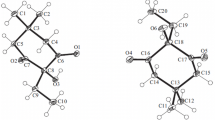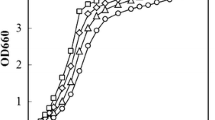Summary
Ethanol inhibition of several hydrolases (sucrase, maltase, trehalase, melezitase and cellobiase) has been measured in both highly ethanol-tolerant Saccharomyces strains (R) and in Candida strains less tolerant to ethanol (S). Cells were either grown in the presence of ethanol and the activities of the enzymes measured without preincubation in this alcohol (“in situ” inhibition assay), or the culture was grown in the absence of ethanol and the activities of the enzymes were determined after preincubation and in the presence of this compound (“in vitro” inhibition assay). Ethanol inhibition (Ki values) of sucrase, maltase, trehalase, and melezitase was quite different for these different enzymes in the same strain (R or S), but similar for the same enzyme in different strains (R and S). The Ki values for cellobiase, which is absent from the R strain, were higher when induced than at the basal level and higher in in vitro assays than in in situ assays. This suggests that the inhibition observed in situ is mainly the result of an inhibition of other proteins related to cellobiase (i.e., those involved in its synthesis) but not a direct inactivation of the enzyme by ethanol. Accordingly, when hybrids between Saccharomyces (R) and Candida (S) strains were constructed by protoplast fusion, and cellobiase was measured in the parental Candida strain and some of the hybrids, there was an increase in the Ki values in the in situ assays from 2.25% ethanol in Candida to 5.5% in some of the hybrids.
Similar content being viewed by others
References
Aguilera A, Benítez T (1986) Arch Microbiol 143:337–344
Baulcombe D, Buffard D (1983) Planta 157:493–498
Calderón IL, Cerdá-Olmedo E (1982) Mutat Res 108:133–146
Casey GP, Ingledew WM (1986) CRC Crit Rev Microbiol 13:219–280
D'Amore T, Stewart GG (1977) Enzyme Microbiol Technol 9:321–330
Dickson RC (1980) Gene 10:347–352
Farahnak F Seki T, Ryu DDY, Ogrydziak D (1986) Appl Environ Microbiol 51:995–1003
Gondé P, Blondin B, Ratomahenina R, Arnaud A, Galzy P (1982) J Ferment Technol 60:579–584
Gondé P, Blondin B, Leclerc M, Ratomahenina R, Arnaud A, Galzy P (1984) Appl Environ Microbiol 48:265–269
Jiménez J, Benítez T (1986) Appl Microbiol Biotechnol 25:150–154
Jiménez J, Benítez T (1987) Curr Genet 12:421–428
Jiménez J, Benítez T (1988a) Curr Genet 13:461–469
Jiménez J, Benítez T (1988b) Appl Environ Microbiol 54:917–922
Johannsen E, Eagle L, Bredenhann G (1985) Curr Genet 9:313–319
Jonge P, Jongh FCM, Meijers R, Steensma HY, Scheffers WA (1986) Yeast 2:579–614
Klinner U, Boucher F (1985) Curr Genet 9:619–621
Kohchi C, Toh-e A (1986) Mol Gen Genet 203:89–94
Lee H, Biely P, Latta RK, Barbosa MFS, Schneider H (1986) Appl Environ Microbiol 52:320–324
Llorente P, Sols A (1969) In: Abstracts of 6th FEBS Meeting. Madrid, p 123
Lowry OH, Rosebrough NI, Farr AI, Randall RJ (1951) J Biol Chem 193:265–275
Maleszka R, Wang PY, Schneider H (1982) Can J Biochem 60:144–148
Nagodawithana TW, Whitt JT, Cutaia AJ (1977) ASBC J 35:179–183
Pina A, Calderón IL, Benítez T (1986) Appl Environ Microbiol 51:995–1003
Rosa MF Sá Correia I, Novais JM (1987) Biotechnol Lett 9:441–444
Sherman F, Fink GR, Hicks JB (1986) Methods in yeast genetics. Cold Spring Harbor Laboratory, Cold Spring Harbor, NY
Shepherd MG, Poulter RTM, Sullivan PA (1985) Annu Rev Microbiol 39:579–614
Skipper N, Sutherland M, Davies RW, Kilburn D, Miller RC, Warren A, Wong R (1986) Science 230:958–960
Spencer JFT, Bizeau C, Reynolds N, Spencer DM (1985a) Curr Genet 9:649–652
Spencer JFT, Spencer DM, Bizeau C, Martini AV, Martini A (1985b) Curr Genet 9:623–625
Spencer-Martins I (1982) Appl Environ Microbiol 44:1253–1257
Toivola A, Yarrow D, Bosch E, Dijken JP, Scheffers WA (1984) Appl Environ Microbiol 47:1221–1223
Toyomasu T, Mori K (1987) Agric Biol Chem 51:935–937
Tubb RS (1984) CRC Crit Rev Biotechnol 1:241–261
Wilson JJ, Khachatourians GG, Ingledew WM (1982) Mol Gen Genet 186:95–100
Author information
Authors and Affiliations
Rights and permissions
About this article
Cite this article
Martín-Rendón, E., Jiménez, J. & Benítez, T. Ethanol inhibition of Saccharomyces and Candida enzymes. Curr Genet 15, 7–16 (1989). https://doi.org/10.1007/BF00445746
Received:
Accepted:
Issue Date:
DOI: https://doi.org/10.1007/BF00445746




